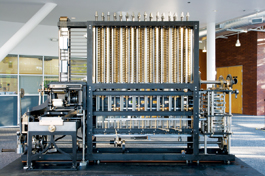home | metro silicon valley index | the arts | visual arts | review

WHEELS GO ROUND AND ROUND: Charles Babbage's Difference Engine No. 2 is 7 feet tall and weighs 5 tons.
Number Cruncher
The Computer History Museum in Mountain View cranks up a working model of Charles Babbage's Victorian calculator
By Andrea Frainier
BEFORE Apple, IBM and Microsoft, there was Charles Babbage, the grandfather of computers. And after more than a century and a half of waiting, Silicon Valley finally gets its chance to see Babbage's Difference Engine No. 2, a working version of one of the earliest computer designs. The Difference Engine was designed 159 years ago by Charles Babbage (1791–1871). Unfortunately, "Charles Babbage's dream was never realized," explained Len Shustek, chairman of the Computer History Museum in Mountain View, at a preview unveiling. "He never built this machine; he never built any of his engines. He died a bitter man because he viewed himself a failure." A model of the Difference Engine will be on display at the museum starting May 10.
The fully functional engine, the second successful model built from Babbage's design, stands 7 feet tall and stretches 11 feet wide; it weighs 5 tons and was built out of 8,000 parts of bronze, cast iron and steel-. When the handle is turned, the intricate Victorian engine springs to life. The gears, levers and wheels work seamlessly together to calculate tables of polynomial functions up to 31 decimal places, serving the same function as a modern calculator. Doron Swade, former curator at the Science Museum in London, and guest curator at the Computer History Museum, said Babbage wanted to build an automatic computing engine that would eliminate the risk of human error in mathematical tables: "There were fears at the time that printed mathematical tables were full of errors and people needed tables to do almost anything—for navigation at sea, for finance, for science, for engineering."
Swade has been on a personal mission to make Babbage's Difference Engine a reality since he began researching the inventor in 1985. Staying faithful to Babbage's design, Swade constructed the first Difference Engine at the Science Museum in 2002. The project took 17 years to complete. The second Difference Engine took six years to build. Both engines were constructed by Swade and a team of two engineers.
Nathan Myhrvold, former chief technology officer of Microsoft, commissioned Swade to build the second engine because he wanted to give people the opportunity to look back into history. "Silicon Valley and the technology industry is all about progress. ... There's an obsession with speed and moving forward and moving fast," Myhrvold said. "Some understanding of the past is still, I think, very relevant for the future."
Swade also wanted to give curious guests the chance to travel back in time and think about their own reactions if they viewed a machine like Babbage's. "That's really the function of an artifact in a museum, to familiarize someone and to actually put them in a frame of mind to encourage and invite speculations about how the present might be if it's other than it is." The Difference Engine will be on display for a year at the museum before it is transported to Myhrvold's private collection.
THE BABBAGE ENGINE goes on display May 10 at the Computer History Museum, 1401 N. Shoreline Blvd., Mountain View. There will be an open house with engine demonstrations on May 10, noon-–5pm, and a lecture on Babbage and his engines at 2:30pm. The museum is open Wednesday, Friday, Sunday, 1–4pm, and Saturday, 10am-5pm. Admission is free. (650.810.1010) See more pictures of the Difference engine online at www.metroactive.com.
Send a letter to the editor about this story.
|
|
|
|
|
|